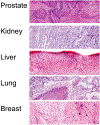Current Landscape of Advanced Imaging Tools for Pathology Diagnostics
- PMID: 38311312
- PMCID: PMC12054849
- DOI: 10.1016/j.modpat.2024.100443
Current Landscape of Advanced Imaging Tools for Pathology Diagnostics
Abstract
Histopathology relies on century-old workflows of formalin fixation, paraffin embedding, sectioning, and staining tissue specimens on glass slides. Despite being robust, this conventional process is slow, labor-intensive, and limited to providing two-dimensional views. Emerging technologies promise to enhance and accelerate histopathology. Slide-free microscopy allows rapid imaging of fresh, unsectioned specimens, overcoming slide preparation delays. Methods such as fluorescence confocal microscopy, multiphoton microscopy, along with more recent innovations including microscopy with UV surface excitation and fluorescence-imitating brightfield imaging can generate images resembling conventional histology directly from the surface of tissue specimens. Slide-free microscopy enable applications such as rapid intraoperative margin assessment and, with appropriate technology, three-dimensional histopathology. Multiomics profiling techniques, including imaging mass spectrometry and Raman spectroscopy, provide highly multiplexed molecular maps of tissues, although clinical translation remains challenging. Artificial intelligence is aiding the adoption of new imaging modalities via virtual staining, which converts methods such as slide-free microscopy into synthetic brightfield-like or even molecularly informed images. Although not yet commonplace, these emerging technologies collectively demonstrate the potential to modernize histopathology. Artificial intelligence-assisted workflows will ease the transition to new imaging modalities. With further validation, these advances may transform the century-old conventional histopathology pipeline to better serve 21st-century medicine. This review provides an overview of these enabling technology platforms and discusses their potential impact.
Keywords: artificial intelligence; histology; microscopy; multiomics; slide-free; stain-free.
Copyright © 2024 United States & Canadian Academy of Pathology. Published by Elsevier Inc. All rights reserved.
Conflict of interest statement
Declaration of Competing Interest
R.L. is a cofounder of MUSE Microscopy Inc, now part of SmartHealth Inc, and of Histolix, Inc, commercializing FIBI and DUET technologies. T.A. has no relevant disclosures.
Figures





Similar articles
-
A Pilot Validation Study Comparing Fluorescence-Imitating Brightfield Imaging, A Slide-Free Imaging Method, With Standard Formalin-Fixed, Paraffin-Embedded Hematoxylin-Eosin-Stained Tissue Section Histology for Primary Surgical Pathology Diagnosis.Arch Pathol Lab Med. 2024 Mar 1;148(3):345-352. doi: 10.5858/arpa.2022-0432-OA. Arch Pathol Lab Med. 2024. PMID: 37226827 Free PMC article.
-
Comparing histologic evaluation of prostate tissue using nonlinear microscopy and paraffin H&E: a pilot study.Mod Pathol. 2019 Jul;32(8):1158-1167. doi: 10.1038/s41379-019-0250-8. Epub 2019 Mar 26. Mod Pathol. 2019. PMID: 30914763 Free PMC article.
-
Accelerating Cancer Histopathology Workflows with Chemical Imaging and Machine Learning.Cancer Res Commun. 2023 Sep 18;3(9):1875-1887. doi: 10.1158/2767-9764.CRC-23-0226. Cancer Res Commun. 2023. PMID: 37772992 Free PMC article.
-
Whole Slide Imaging Technology and Its Applications: Current and Emerging Perspectives.Int J Surg Pathol. 2024 May;32(3):433-448. doi: 10.1177/10668969231185089. Epub 2023 Jul 12. Int J Surg Pathol. 2024. PMID: 37437093 Review.
-
Slide Over: Advances in Slide-Free Optical Microscopy as Drivers of Diagnostic Pathology.Am J Pathol. 2022 Feb;192(2):180-194. doi: 10.1016/j.ajpath.2021.10.010. Epub 2021 Nov 10. Am J Pathol. 2022. PMID: 34774514 Free PMC article. Review.
Cited by
-
Can Artificial Intelligence Whole Slide Image-Based Methods Predict Kidney Function?Kidney Int Rep. 2025 Jun 23;10(8):2535-2538. doi: 10.1016/j.ekir.2025.06.034. eCollection 2025 Aug. Kidney Int Rep. 2025. PMID: 40814611 Free PMC article. No abstract available.
-
From Cell Populations to Molecular Complexes: Multiplexed Multimodal Microscopy to Explore p53-53BP1 Molecular Interaction.Int J Mol Sci. 2024 Apr 25;25(9):4672. doi: 10.3390/ijms25094672. Int J Mol Sci. 2024. PMID: 38731890 Free PMC article.
-
Digital spatial profiling for pathologists.Virchows Arch. 2025 May;486(5):971-981. doi: 10.1007/s00428-024-03955-w. Epub 2024 Nov 5. Virchows Arch. 2025. PMID: 39499318
-
ML-driven segmentation of microvascular features during histological examination of tissue-engineered vascular grafts.Front Bioeng Biotechnol. 2024 Jun 26;12:1411680. doi: 10.3389/fbioe.2024.1411680. eCollection 2024. Front Bioeng Biotechnol. 2024. PMID: 38988863 Free PMC article.
References
-
- Bancroft JD, Gamble M. Theory and Practice of Histological Techniques. 6th ed. Churchill Livingstone; 2008.

